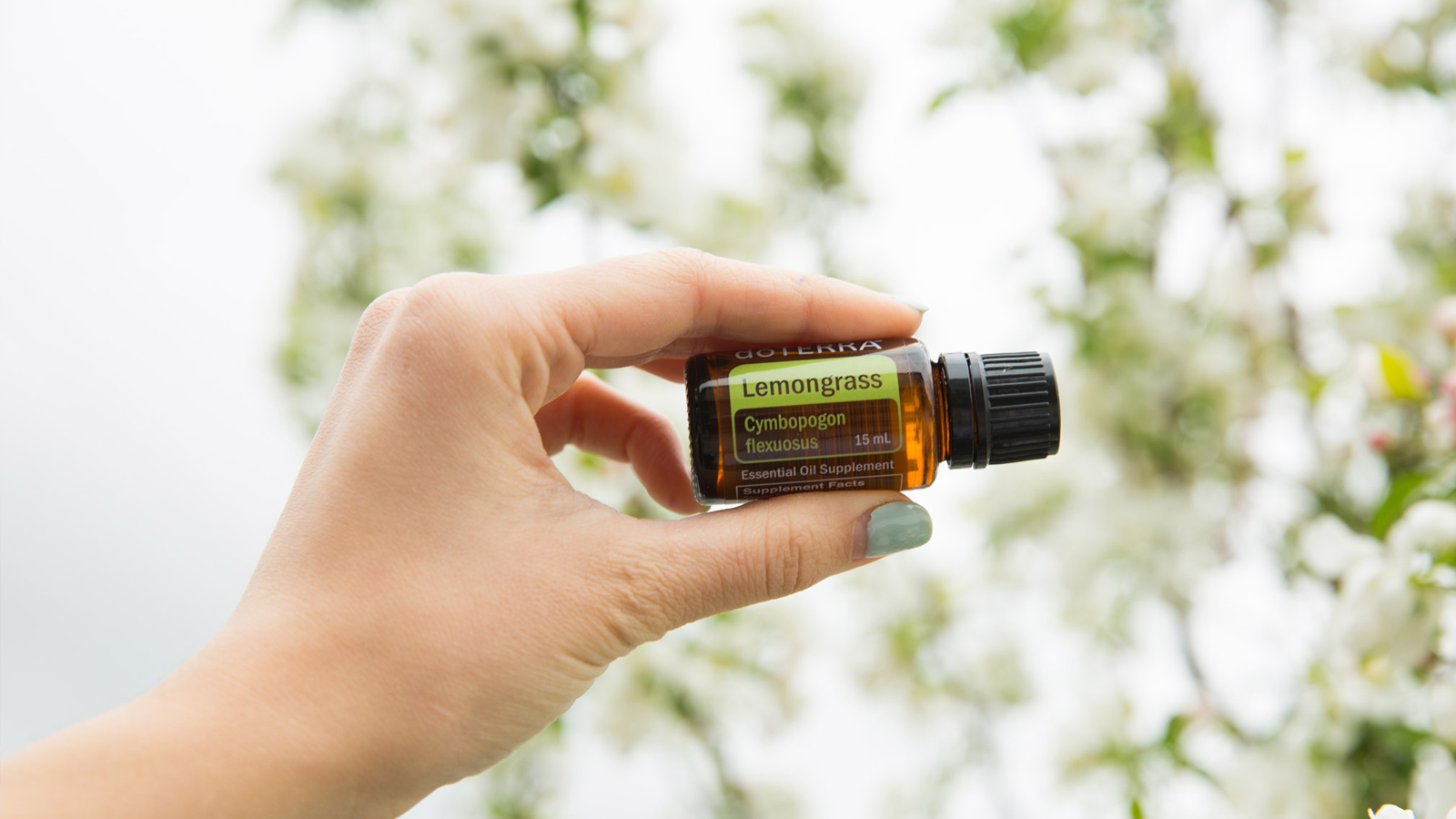Origin: a Latin derivative
meaning "Gift of the Earth."
Lemongrass Oil Uses and Benefits

Lemongrass Oil Product Description
Grown by family farmers in Southern India, lemongrass produces a smoky, citrus essential oil that offers a variety of benefits to the user. For years, lemongrass has been used in Asian cuisine for soups, teas, curries, and seafood. However, the uses for Lemongrass oil extend far beyond the kitchen. With a pungent aroma, Lemongrass essential oil is a favorite for massage, offers purifying benefits for the skin, and promotes a positive outlook. Whether applied topically or used aromatically, the uses and benefits of Lemongrass essential oil are widely diverse.
Where to Buy Lemongrass Oil
If you are ready to add Lemongrass essential oil to your essential oil collection, visit our Lemongrass oil page to see how to purchase your own. Each doTERRA essential oil undergoes extensive testing using CPTG® methods, in order to ensure the purity and quality of each bottle of oil. When you are looking for high quality, potent Lemongrass essential oil, doTERRA can provide a refreshing, pure oil that has been created with extreme care.
Lemongrass Essential Oil Uses and Benefits
One way to experience the benefits of Lemongrass essential oil is by diffusing the oil in your diffuser at home. Consider diffusing Lemongrass oil when you want to overpower feelings of nervousness, or eliminate mental fatigue. Diffusing Lemongrass essential oil can also help promote a positive outlook and heighten your awareness. Another benefit of diffusing Lemongrass oil is the refreshing, herbaceous aroma of the oil. If you want to experience the aromatic benefits of Lemongrass essential oil but don’t have time to diffuse it, place one drop in the palm of your hand, rub your hands together, and inhale softly for up to 30 seconds or longer as desired.
The aldehydes in Lemongrass essential oil also make Lemongrass useful for naturally repelling insects. Diffusing Lemongrass essential oil or even using it topically can help keep bugs away. Diffuse Lemongrass oil inside or outside on your porch or patio to keep away mosquitos and bugs. If you are worried about keeping bugs off of your body, rub or spritz Lemongrass essential oil on your skin before you go outside.
Because Lemongrass is a soothing oil, it is commonly used for massage. The refreshing aroma combined with the oil’s soothing properties make it a popular choice for massage therapy. It also holds purifying benefits for the skin, making it a desirable oil to use during massage sessions. If you use Lemongrass essential oil for massage, dilute it with a carrier oil like doTERRA Fractionated Coconut Oil. Apply the diluted oil to muscles and joints for a soothing sensation that makes for a tranquil massage.
The soothing properties of Lemongrass essential oil also make it helpful for the body after physical activity. Consider applying Lemongrass essential oil topically where needed after a hard workout to utilize the soothing properties of the oil. You can also dilute Lemongrass and apply it after a long run for a refreshing feeling. No matter what kind of workout you choose, Lemongrass essential oil can help soothe the body after exertion during physical activity.
Lemongrass contains purifying and toning benefits for the skin, and can be used in your skin care routine to help promote pure, toned skin. Consider adding a few drops of Lemongrass essential oil to your daily cleanser or moisturizer to help tone and purify skin. Similar to Melaleuca, Lemongrass oil can also help promote the appearance of healthy fingernails and toenails. To experience these benefits of Lemongrass, try combining it with Melaleuca essential oil and apply the mixture to your fingernails and toenails to help them look and feel clean.
Plant Description
The evergreen lemongrass plant, also known as Cymbopogon flexuosus, is a tall, perennial plant native to India and other surrounding countries. Lemongrass has long, aromatic leaves that are cut and steam-distilled to produce Lemongrass essential oil. The lemongrass plant is often used to extract essential oil to be used in perfumes, detergents, soaps, etc. The oil can also be taken internally, which makes lemongrass quite popular in the food industry for baked goods, gums, and candies.
Chemistry of Lemongrass Essential Oil
Main Chemical Components: Geranial, neral
The chemical makeup of Lemongrass essential oil includes the constituents geranial and neral, which are aldehydes. Typically, aldehydes are known for their distinctly potent fragrances, which is evident in the case of Lemongrass essential oil. Aldehydes have many functions within essential oils, including the ability to cleanse surfaces. They can also lessen feelings of stress when diffused. Geranial and neral are also known as soothing aldehydes, which is why Lemongrass and Melissa oil are both soothing oils that share similarities in chemical structure.
Sourcing
Harvesting lemongrass is a labor-intensive process, but for families in Southern India, it has been a way of life for generations. doTERRA chose Southern India as a sourcing location because of the high levels of rain fall in the area. A greater amount of rainfall creates a higher citral content in the lemongrass, which makes it superior for essential oil use.
During harvest time, farmers hike five miles up a steep mountain and work for roughly seven days to harvest a 100-acre plantation. Lemongrass is harvested by hand, using a sickle—which is part of what makes the harvesting process so physically demanding. Once the lemongrass is harvested and gathered, the farmers walk the five miles back down the mountain, each carrying a lemongrass bundle on top of their head.
After the lemongrass is harvested, it goes through the process of steam distillation. Once distilled, the crude oil is passed on to a manufacturer who produces the Lemongrass essential oil. While the oil is with the manufacturer, it goes through stages of refining, filtration, and blending. The oil then undergoes a series of tests before it qualifies for export—the oil must be of the highest quality to be acceptable to distribute. Though the process of harvesting and producing Lemongrass essential oil requires hard labor and attention to detail, this process matches the high standards that doTERRA has for producing quality essential oils.
Oils that blend well with Lemongrass oil
Because Lemongrass oil includes subtle citrus notes; a pungent, smoky aroma; and a refreshing, herbaceous scent, it blends well for diffusion with a variety of oils that share similar qualities. Blend Lemongrass oil with the herbal scents of Basil, the fresh aroma of Spearmint, or the warm, spicy fragrance of Cardamom oil.
Cautions
Possible skin sensitivity. Keep out of reach of children. If you are pregnant, nursing, or under a doctor’s care, consult your physician. Avoid contact with eyes, inner ears, and sensitive areas.





